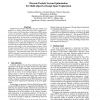RTS
2006
14 years 6 days ago
2006
Abstract The increasing complexity of heterogeneous systems-on-chip, SoC, and distributed embedded systems makes system optimization and exploration a challenging task. Ideally, a ...
DAC
2010
ACM
14 years 15 days ago
2010
ACM
Given the increasing complexity of multi-processor systems-onchip, a wide range of parameters must be tuned to find the best trade-offs in terms of the selected system figures of ...
DSD
2008
IEEE
14 years 2 months ago
2008
IEEE
Platform-based design represents the most widely used approach to design System-On-Chip (SOC) applications. In this context, the Design Space Exploration (DSE) phase consists of o...
DAC
2005
ACM
14 years 2 months ago
2005
ACM
This paper focuses on designing network processing software for embedded processors. Our design flow CRACC represents an efficient path to implementation based on a modular applic...
ASPDAC
2005
ACM
14 years 2 months ago
2005
ACM
— Architecture Description Languages (ADLs) are widely used to perform design space exploration for Application Specific Instruction Set Processors (ASIPs). While the design spa...
ASPDAC
2005
ACM
14 years 2 months ago
2005
ACM
— We present SoCExplore, a framework for fast communicationcentric design space exploration of complex SoCs with networkbased interconnects. Speed-up in exploration is achieved t...
CASES
2008
ACM
14 years 2 months ago
2008
ACM
The Field Programmable Compressor Tree (FPCT) is a programmable compressor tree (e.g., a Wallace or Dadda Tree) intended for integration in an FPGA or other reconfigurable device....
ASPDAC
2008
ACM
14 years 2 months ago
2008
ACM
- In the design process of a reconfigurable accelerator employing in an embedded system, multitude parameters may result in remarkable complexity and a large design space. Design s...
CODES
2000
IEEE
14 years 3 months ago
2000
IEEE
We present an analysis of the benefits and drawbacks of function and object based models in system specification. Functional models should be used for functional design space expl...
CASES
2003
ACM
2003
ACM
A hierarchical approach for energy efficient application design using heterogeneous embedded systems
14 years 4 months ago
Several features such as reconfiguration, voltage and frequency scaling, low-power operating states, duty-cycling, etc. are exploited for latency and energy efficient application ...






